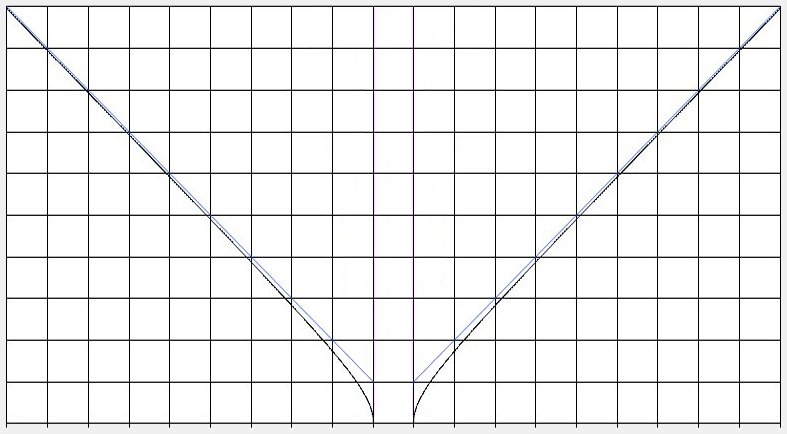| Horn/Waveguide dimensions and beamwidth [message #71828] |
Sun, 18 March 2012 20:59  |
 |
 Wayne Parham
Wayne Parham
Messages: 18985
Registered: January 2001
|
Illuminati (33rd Degree) |
|
|
 Conical and Oblate Spheroidal 90° Flares
Conical and Oblate Spheroidal 90° Flares
This shows a cross-section of a conical flare and of an oblate spheroidal flare. It might help to visualize the relationship between mouth size and length for both flare shapes. The conical flare is used in many constant directivity horns, and the oblate spheroidal flare is what is used in most waveguides for compression drivers.
Conical horns are straight sided, just like a megaphone. The mouth can be round or square, but the flare, itself, is straight. That's the shape that provides constant directivity for a spherical wave source. The wall angle sets the beamwidth, at frequencies where the mouth is acoustically large.
It is really easy to calculate the dimensions of a conical horn, if you know the desired beamwidth. The following formula defines the ratio:
Tan θ = radius / depth.
For a 90° horn, the radius always equals the length. The profile forms a right triangle with the hypotenuse being the flare, and since the angle is 45°, both the opposite and adjacent sides are equal in length. A 90° conical horn that's 12" wide is 6" long. You have to add the throat diameter, of course, so for a 1" throat, the total mouth size would then be 13" wide.
Some designers modify the basic shape to assist in transitions. The earliest CD horns used a two-section approach, with the final flare being wider than the desired beamwidth. This is because mouth diffraction caused the pattern to narrow as frequency dropped, just before it widened as frequency dropped further and the horn lost all pattern control. The wall angle from throat to about 2/3rd set the beamwidth, and the final 1/3rd was widened to counter the narrowing beamwidth at the lowest frequencies.
One problem for using this kind of horn with compression drivers is they don't present the horn with a spherical wave, they deliver a plane wave. It can be converted into a spherical wave either using a diffraction slot in the mouth or by gently "nudging" it into a spherical wave by radiusing the throat, blending the throat angle into the final flare angle with a graceful transition. The oblate spheroidal flare is the best choice for this transition.
The oblate spheroidal profile is defined by conoidal surfaces tangent to an oblate shperoid. The resulting curve is a hyperboloid of one sheet whose asymptotes pass through the origin (x/y axis) inclined at an angle cos-1 with the z axis. It is very much like a conical horn, providing most of the curved blending in the throat section. It is actually still bending along the entire length, only approaching a conical flare but never reaching it. On casual inspection you could never see this though. It looks like a conical horn with a radiused throat.
The radiused throat formed by an oblate spheroidal profile adds a little bit of length compared to a conical profile. You can kind of estimate it as if it were a conical horn, using the same formula mentioned above. But it will be longer than a conical expansion of the same exit angle.
It cannot be made shorter than this and still maintain 90° beamwidth. A shorter horn implicity defines a wider beamwidth, because the angle must be increased to match the throat with the mouth.
Not all designers use the oblate spheroidal profile for waveguides. And even of those that do, almost all modify it to radius the mouth, just like mentioned above for CD horns, to reduce mouth diffraction. It is desirable to smoothly blend the mouth exit angle to the baffle. This adds both width and depth to the basic waveguide shape.
Some designers have used other similar shapes, from quadratics to parabolas to arbitrary radiuses. I suspect that other curves can be used to good effect, provided the curves are reasonably close to an oblate spheroidal horn profile. I have some experience with two different horns that are indistinguishable from a true oblate spheroidal waveguide by acoustic measurements, yet one has a quadratic shape, the other an oblate spheroidal shape. So I am comfortable with the devices made by these other designers, that they are able to provide the same quality as a true OS shape.
However, I am not comfortable with a horn/waveguide that is too short. It cannot help but provide wide beamwidth because the angles don't support a narrower beam. It also usually suffers from response ripple, where resonant modes fall in the passband. This is reduced somewhat by mouth radiusing, but too short a horn can suffer from resonant peaking too. In fact, that's the more common problem with most modern waveguides because they are attempting to provide 90° wall angle, and then go wider than that near the mouth to mitigate waistbanding. This takes the already poor loading of a conical horn or waveguide and makes it even worse. Devices like that are almost always resonant and will suffer from peaking in the first octave or two, sometimes even higher. The right flare profile is a delicate balance of competing priorities.
|
|
|
|
|
|







